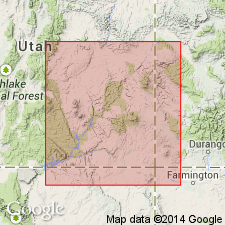
- Usage in publication:
-
- Owl Rock member*
- Modifications:
-
- First used
- Dominant lithology:
-
- Siltstone
- Limestone
- AAPG geologic province:
-
- Paradox basin
Summary:
Intent to name and type locality not stated. First published use as a member of Upper Triassic Chinle formation. Present in southeast UT in Paradox basin; absent in San Rafael Swell area, Emery Co, and at Moab, Grand Co, UT in Paradox basin. Also recognized in northeast AZ in Black Mesa basin and as far as east-central NM in San Juan basin. Conformably overlies Petrified Forest member of Chinle, or Moss Back member of Chinle where Petrified Forest is missing. Base marked by change from variegated bentonitic claystone (Petrified Forest) to red non-bentonitic siltstone (Owl Rock). Conformably underlies and intertongues with Church Rock member (first used) of Chinle, or Wingate sandstone where Church Rock is missing. Absence at Swell and Moab areas may be due to lateral replacement by Church Rock member. Composed of pale red to red-brown structureless siltstone interstratified with thin to thick beds of red and gray, dense limestone. Limestone makes up 5 to 10 percent of the member. Ranges from 0 to 450 ft thick; is generally 150-250 ft thick in southeast UT. Corresponds to B division of Chinle. Cross section. Block diagram. Nomenclature chart.
Source: GNU records (USGS DDS-6; Denver GNULEX).
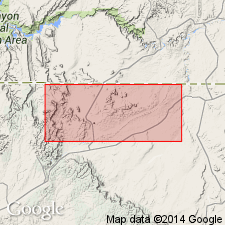
- Usage in publication:
-
- Owl Rock member*
- Modifications:
-
- Overview
- Dominant lithology:
-
- Limestone
- Mudstone
- AAPG geologic province:
-
- Black Mesa basin
- Paradox basin
Summary:
First detailed published description as a member (1 of 4 members) of the Upper Triassic Chinle formation. Intent to name not stated. Type "locality" is near base of Owl Rock, Navajo Co, AZ in the Black Mesa basin. Extends northward into Monument Valley, San Juan Co, UT, Paradox basin. Type "section" measured at Owl Rock where the member is 166 ft thick, consists primarily of interbedded gray-green limestone that has black angular chert masses, is a cliff former and weathers to blocky masses, and of red-brown to mottled, slope-forming mudstone. A bed of gray to purple ledge-forming claystone, and a brown massive siltstone present at type section. Overlies Petrified Forest member of Chinle. Underlies Church Rock member of Chinle. Ranges from 120 to 166 ft thick. Upper contact placed at uppermost limestone ledge in the mudstone and limestone sequence. Overlying Church Rock is red brown. Locally Owl Rock and Church Rock intertongue. Fossil pelecypod. Fossil wood. Deposited under lacustrine and fluviatile conditions. Of Late Triassic age. Geologic map. Stratigraphic column. Called "Division B" of Chinle by Gregory (1917).
Source: GNU records (USGS DDS-6; Denver GNULEX).
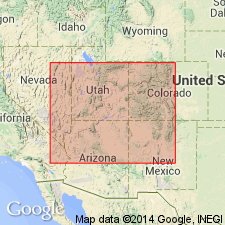
- Usage in publication:
-
- Owl Rock Member*
- Modifications:
-
- Overview
- Areal extent
- AAPG geologic province:
-
- Plateau sedimentary province
- Paradox basin
- San Juan basin
- Black Mesa basin
Summary:
Is one of several members of Upper Triassic Chinle Formation present in northeast AZ, easternmost Coconino Co, Plateau sedimentary province, Apache and Navajo Cos, Black Mesa basin; in northwest NM, Valencia, McKinley, and Rio Grande Cos, San Juan basin; and in southeast UT, San Juan, Wayne, and Emery Cos, Paradox basin, and Kane Co, Plateau sedimentary province. Ranges from 0 to 500+ ft thick. Isopach map. Nomenclature diagram. Overlies Petrified Forest Member. Underlies Church Rock Member of Chinle south of Laguna Creek, AZ and underlies the equivalent of the Church Rock, the Rock Point Member of the Wingate Sandstone north of Laguna Creek. Contacts poorly defined at most places. Lower contact placed at change from bentonitic (Petrified Forest) to nonbentonitic (Owl Rock) rocks--a contact that can be relatively precisely chosen. Upper contact placed at top of highest limestone bed. Lithologic content and variation discussed. Measured sections. One section measured 2.5 mi N 20 deg W of Owl Rock [near the type section]. Fresh-water pelecypods and gastropods occur in limestone beds. Continental origin.
Source: GNU records (USGS DDS-6; Denver GNULEX).
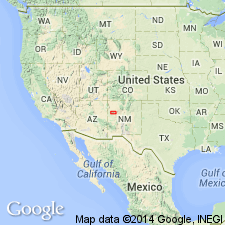
- Usage in publication:
-
- Owl Rock Member*
- Modifications:
-
- Revised
- AAPG geologic province:
-
- San Juan basin
Summary:
Unconformably underlies the newly named Iyanbito Member of the Entrada Sandstone in the southern San Juan basin. Iyanbito of this report was called Lukachukai Member of Wingate Sandstone in earlier reports. Owl Rock-Iyanbito contact marked by lag concentrations of chert and quartz pebbles in basal Iyanbito--a chert-pebble unconformity. The unconformity is thought to be widespread throughout the Colorado Plateau and adjacent areas. Large-scale mudcracks present at top of Chinle. The mudcracks are as much as 0.8 m wide and 3 m deep, and they are filled with sandstone and pebbles form the overlying Iyanbito. The multicolored claystone, siltstone, sandstone, and limestone of the Chinle that were deposited under humid conditions in freshwater fluviatile, lacustrine, and marsh environments contrast with the sandstone and siltstone of the Entrada that were deposited by wind under arid conditions.
Source: GNU records (USGS DDS-6; Denver GNULEX).
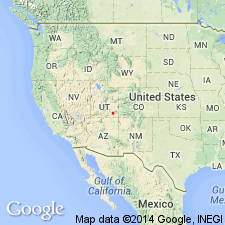
- Usage in publication:
-
- Owl Rock Member*
- Modifications:
-
- Overview
- AAPG geologic province:
-
- Paradox basin
Summary:
Is the fifth member from base (of six) of Upper Triassic Chinle Formation studied in the White and Red Canyon areas, San Juan Co, UT, in the Paradox basin. Overlies Petrified Forest Member of Chinle gradationally. Underlies Church Rock Member of Chinle. Lungfish burrows locally abundant in limestones and subjacent siltstones. Occurrence of burrows in both lithologies indicates deposition in lacustrine basin and a climate characterized by wet and dry periods.
Source: GNU records (USGS DDS-6; Denver GNULEX).
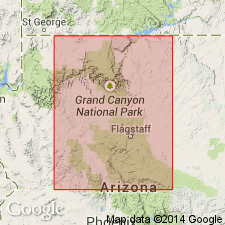
- Usage in publication:
-
- Owl Rock Member
- Modifications:
-
- Biostratigraphic dating
- Overview
- AAPG geologic province:
-
- Plateau sedimentary province
Summary:
A new vertebrate fauna has been collected from the upper lacustrine-marginal facies of the Owl Rock Member of the Chinle Formation on Ward Terrace, Coconino County, Arizona (Plateau sedimentary province). The vertebrates include phytosaur, metoposaur, aetosaur, rauisuchian, fabrosaurid, and hybodont shark. Presence of the phytosuar (RUTIODON TENUIS) and the aetosaur (TYPOTHORAX) indicate a Norian age. This is the first reported occurrence of vertebrate fossils of this age in Arizona. The fauna present indicates presence of perennial bodies of water and lithologies suggest episodic lacustrine and fluvial periods. Formation of soil suggests expansion and contraction of lacustrine environment. Owl Creek gradationally overlies Petrified Forest Member of Chinle. Separated from overlying Wingate Sandstone of Glen Canyon Group by the J-O unconformity. Underlies Rock Point Member of Chinle at some localities. May be younger than Dockum Group. Precise location of Carnian-Norian boundary within upper Petrified Forest or lower Owl Rock cannot be made. Report includes fossil list, cross section.
Source: Modified from GNU records (USGS DDS-6; Denver GNULEX).
For more information, please contact Nancy Stamm, Geologic Names Committee Secretary.
Asterisk (*) indicates published by U.S. Geological Survey authors.
"No current usage" (†) implies that a name has been abandoned or has fallen into disuse. Former usage and, if known, replacement name given in parentheses ( ).
Slash (/) indicates name conflicts with nomenclatural guidelines (CSN, 1933; ACSN, 1961, 1970; NACSN, 1983, 2005, 2021). May be explained within brackets ([ ]).

